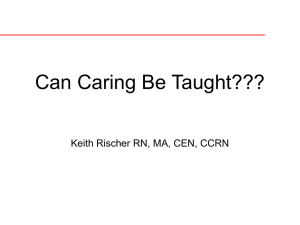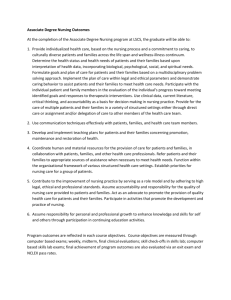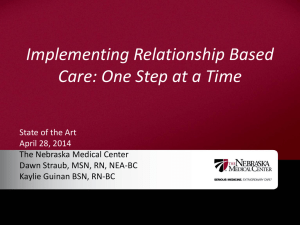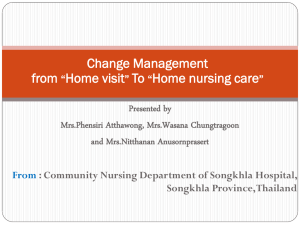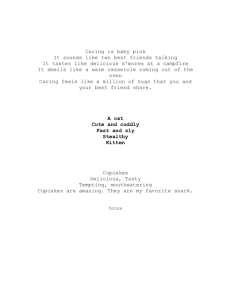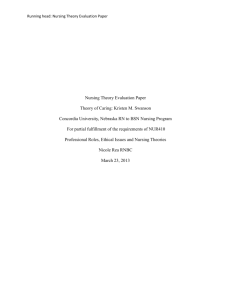Swanson's Caring Theory: A Critical Analysis
advertisement
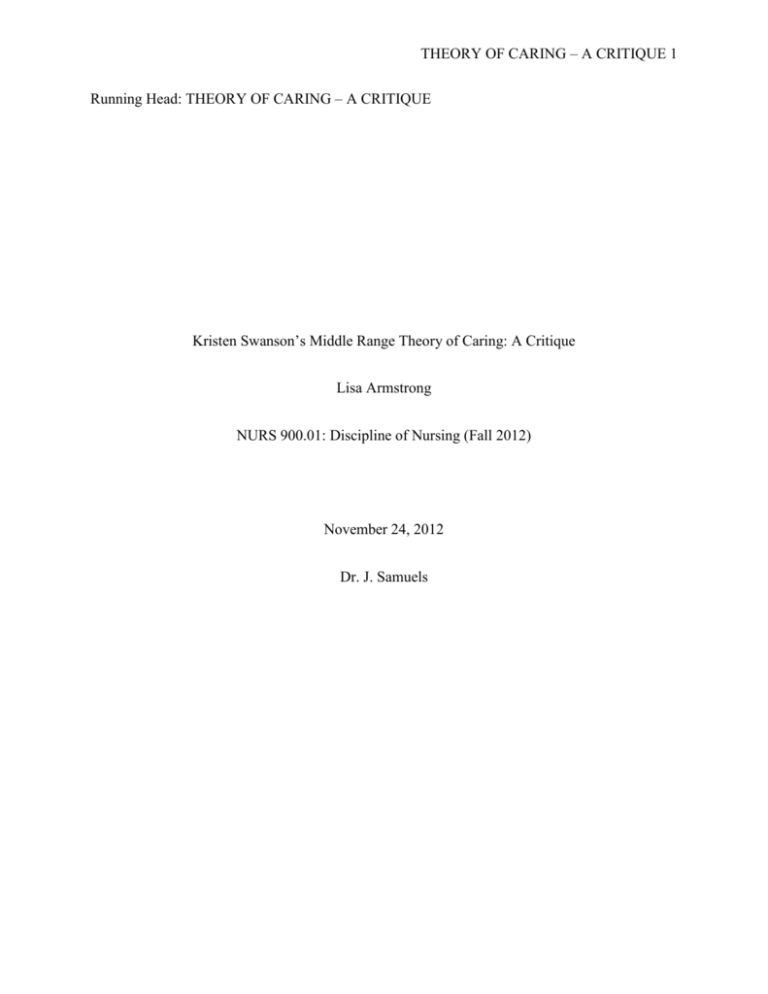
THEORY OF CARING – A CRITIQUE 1 Running Head: THEORY OF CARING – A CRITIQUE Kristen Swanson’s Middle Range Theory of Caring: A Critique Lisa Armstrong NURS 900.01: Discipline of Nursing (Fall 2012) November 24, 2012 Dr. J. Samuels THEORY OF CARING – A CRITIQUE 2 Kristen Swanson’s Middle Range Theory of Caring: A Critique Introduction Caring Profession – Definition “A profession that involves taking care of other people. For example: social work and nursing” (Macmillan Dictionary, 2012) Type the word “caring” into the CINAHL database and it returns 24,828 results. Type it into Google, and the figure rockets to over 42 million. It’s a fair assumption to make that the world cares about caring. Indeed, the concepts of care and caring are synonymous with the medical and nursing profession. In fact, society has long coupled the word “health” with “care”, and the word “healthcare” is well on its way to becoming a noun and adjective in its own right (Grammarist.com, 2012). Another more recent example of word coupling with care is the new Patient Protection and Affordable Care Act euphemized Obamacare; yet another illustration of the ubiquitous association of the interrelated concepts of care and health within western contemporary society. As the cornerstone of nursing, the tenets of caring are described extensively in various guises and across multiple sources, both old and new. One of nursing’s earliest grand theorists; Dr. Jean Watson formalized and presented her own Theory of Transpersonal Caring in 1979. An exciting and revolutionary grand theory that has stood the test of time, Watson’s accomplishments are evidenced by the extensive use of her works in current nursing literature over the last three decades, as well as her 2012 Speaking Engagements Calendar (watsoncaringscience.org, 2012), which demonstrates Watson’s influence on an international THEORY OF CARING – A CRITIQUE 3 stage as her teachings reach audiences across the globe from the United States and the United Kingdom, to Mexico, Venezuela, and Italy. The application of caring theory transcends many different health disciplines and health care systems worldwide, including nursing. A relatively limited literature review reveals that Watson’s grand theory has been the inspiration and formed guiding practices for many current middle-range caring theories, such as Falk-Rafael’s Critical Caring Theory (2005) in acute care, Kolcaba’s Comfort Theory (2001) in palliative care, and Wade and Kasper’s Nursing Students’ Perceptions of Instructor Caring (2006) in education to name but a few, demonstrating the wide breadth of application diversity. One such Watson inspired middle-range theory that is particularly versatile in its application within the nursing arena is that of Kristen Swanson’s middle-range Theory of Caring. Swanson’s theory has demonstrated its ability to be “broadly generalizable across different populations” (Chinn & Kramer, 2011, p. 49) and meets the middle-range standard for having a “high explanatory value in the understanding of different phenomena and rather easily applied in practice” (Andershed & Olsson, 2009, p. 598). This paper discusses the extent of application of Swanson’s Theory of Caring within the nursing profession, provides an overview of the theory, a critical analysis, and considers the theory’s application within contemporary nursing practice and institutional health care settings. The Theorist: Kristen Swanson Kristen M. Swanson, RN, PhD, FAAN, is the Dean of the School of Nursing, Alumni Distinguished Professor at the University of North Carolina at Chapel Hill, and Associate Chief Nursing Officer for Academic Affairs at UNC Hospitals. She earned her bachelor degree in THEORY OF CARING – A CRITIQUE 4 nursing from the University of Rhode Island in 1975, her masters in adult health and illness nursing from the University of Pennsylvania in 1978, and a PhD in psycho-social nursing from the University of Colorado, completing her postdoctoral work at the University of Washington (University of North Carolina, 2012; Ray, 2011). Her theory was empirically developed out of three phenomenological studies in separate perinatal contexts carried out in the late eighties and was further developed and refined during the early nineties. Numerous hospitals and health care facilities have since adopted Swanson’s theory of care as a guide to their own nursing services (Ray, 2011) and Swanson continues to consult internationally on implementation of caring theory in clinical practice, research, and education (University of North Carolina, 2012). Theory Description Foundation and Historical Evolution Swanson started out with a “deep interest in understanding what is was like for women to miscarry” (Swanson, 1998) and her caring theory was initially founded through her doctoral work into exploring what caring meant from the perception of women who had miscarried. As a result of her own personal experience with her second newborn child in a NICU setting, her subsequent post-doctoral research led Swanson into the study of nursing care within a NICU environment, and her third study focused on high risk mothers within a public health setting. Initial concepts were formulated during her early studies, and as her research progressed Swanson further clarified and honed the five theoretical categories of caring. As the theory has been further referenced, applied to practice, validated, and tested in several different environments over the last two decades, it has without doubt matured and developed, but the five key categories remain inherently the same. THEORY OF CARING – A CRITIQUE 5 Theory Structure, Concepts, and Definitions Figure 1: Nursing as Informed Caring for the Well-Being of Others, Swanson, 1993, p. 355 The proposed structure of the theory depicts caring as “grounded in maintenance of a basic belief in persons, anchored by knowing the other’s reality, conveyed through being with, and enacted through doing for, and enabling” (Swanson, 1993, p. 354). Knowing is striving to understand an event as it has meaning in the life of the other. “It involves avoiding assumptions, centering on the one(s) cared for, thoroughly assessing all aspects of the client’s condition and reality, and ultimately engaging the self or personhood of the nurse and client in a caring transaction (Swanson, 1998, p. 355). Being With means being emotionally present as a way of “sharing in the meanings, feelings, and lived experience of the one-cared for…not just the side-by-side physical presence, but also the clearly conveyed message of availability and ability to endure with the other” (Swanson, 1998, p. 355). Doing For is “doing for the other what they would do for themselves if it were at all possible…and includes comforting the other, anticipating their needs, performing competently and skillfully, protecting the other from undue harm and ultimately preserving the dignity of the one done for” (Swanson, 1998, p. 356) THEORY OF CARING – A CRITIQUE 6 Enabling helps the other to practice self care, defined as “facilitating the other’s passage through life transitions and unfamiliar events, including coaching, informing, and explaining to the other; supporting the other and allowing her/him to have her/his experience; assisting the other to focus in on important issues; helping her/him to generate alternatives; guiding her/him to think issues through; offering feedback; and validating the other’s reality” (Swanson, 1998, p. 356). Maintaining Belief is sustaining faith in the other’s capacity to get through an event or transition and face a future with meaning. In a 1998 Caring Made Visible interview, Swanson discussed that she had broadened this category to add ‘helping find meaning’ through affirming the other’s experience and the meaning they derive, which may involve working with people around their religious and spiritual needs (Swanson, 1998, p. 354). The theory structure and concepts underpin the authors definition of caring: “Caring is a nurturing way of relating to a valued other person, towards whom one feels a personal sense of commitment and responsibility” (Swanson, 1991, p. 165). Purpose of the Theory Swanson states that the five caring processes are not suggested to be unique to nursing, but are proposed as common features of caring relationships. However, in the context of nursing practice, the theory provides broad guidance for what are considered central caring behaviors that a nurse may undertake in his/her relationship with self, client, and nurse colleagues. The theory helps to facilitate the incorporation of these caring behaviors into daily nursing practice, ensuring that the mainstay of attention remains on the ‘one cared for’ during all nursing THEORY OF CARING – A CRITIQUE 7 interactions. Furthermore, the theory embodies the notion that the nurse and the one cared for are relating to each other and engaged in the process of caring together, culminating in a meaningful relationship and fostering a mutually beneficial desired outcome. Theory Relationships Swanson identifies key relationships that interrelate with the Theory of Caring; persons, health/wellbeing, environment, and nursing. Persons may be an individual, or perhaps an aggregate of individuals, such as families, groups, or societies. Persons may also incorporate future generations or social issues such as access to healthcare. Self is also conceptually regarded in the person category. Environmental relationships are key to caring, and also crucial to the application of Swanson’s Theory of Caring. Swanson notes that “realms of influence are multiple including the cultural, political, economic, social, biophysical, psychological, and spiritual realms,” (1993, p353) recognizing that what is considered client in some situations may serve as context or environment in others, such as community endeavors, school systems, and so forth. Health and well-being are also relationships that intertwine with the theory. All five processes contribute to “assisting clients to attain, maintain, or regain the optimal level of living or wellbeing they choose given their personal and environmental demands, constraints, and resources” (Swanson, 1993, p. 353). Finally, Swanson discusses the relationship of nursing and informed caring, clarifying informed nurse caring as ranging from having novice to expert capacity in practice, and that such therapeutic practices of nurses are grounded in knowledge of nursing, related sciences and the humanities, as well as personal insight and experiential understanding. THEORY OF CARING – A CRITIQUE 8 Critical Reflection Clarity Swanson’s theory of caring clearly delineates boundaries in each of the five subcategories of caring by identifying, describing, and giving examples of caring behaviors that fulfill each caring process, reducing the risk of ambiguity. An example of enabling is clarified as: “Providing information and explanations as well as offering emotional support in the form of allowing and validating the other’s feelings. Enabling often includes assisting the ones cared for to focus on their concerns, generate alternatives, and think through ways to look at or act on a situation” (Swanson, 1991, p. 164) Consistency Although Swanson’s theory has developed over the years to further enhance individual descriptive components of each process, the main five concepts have remained static. An example of this maturation process is the addition of ‘helping find meaning’ in the Maintaining Belief process, which includes affirming the clients experience and the meaning they derive from it, as well as being cognizant of an individual’s spiritual and religious needs (Swanson, 1998). Perhaps part of the strength of this theory is that the fundamental basic constructs have remained relatively unchanged over time, and yet the theory has been able to adapt to new and everevolving practice settings, and from within these different environments grow and change to deliver a more generalizable theory, while still remaining recognizable in its original form. Additionally, Swanson’s theoretical constructs reflect and remain consistent with Jean Watson’s grand Theory of Transpersonal Caring, and the two are often cited together (Mason & Wesorick, 2011, Blessing Hospital, 2012, Winter Haven Hospital, 2012). As a result of this relationship, Swanson’s theory is further endowed with a higher level of credibility. THEORY OF CARING – A CRITIQUE 9 Complexity What makes Swanson’s theory so easily applicable within nursing practice is its simplicity and clarity, especially from a lay perspective. Each process is explicitly defined, providing a caring road map that both the person delivering the care, and the one being cared for, can understand, relate to, agree upon, and engage in. Interestingly, the theory is able to become more or less complex as it is applied to any unique caring context. For example, the basic processes can be described at a macro level in terms of an overarching goal for care delivery from a global perspective – consider the possibility that the World Health Organization could advocate for one specific caring theory for example -- or at an institutional level within the construct of a theoretical framework for care delivery. Conversely, it can also be engaged within a micro system setting, as the theory is utilized in a specific clinical context, such as a model for the delivery of care for persons with dementia, or within the context of caring for high-risk families, as has been demonstrated. Application and Generalizability Swanson’s theory was originally conceived within a perinatal concept, but has been successfully applied across the spectrum of nursing care during the last two decades including palliative care, mental disorders, dementia, parental support groups, home care, and critical care amongst numerous others, demonstrating a parsimonious theory that boasts a broad diversity of application within the context of nursing practice. Additionally, in their Review of Research related to Kristen Swanson’s middle-range theory of caring article, Andershed and Olssen (2009) highlighted six high quality studies that focused on developing measurements from and/or testing Swanson’s theory of caring, and THEORY OF CARING – A CRITIQUE 10 concluded that her theory of caring “provided both a conceptual framework and empirical support for the generalizability of the theory beyond the clinical contexts from which it was generated” (p. 608). Swanson was also recently named as Virginia Mason’s Distinguished Nursing Scholar in August 2012. Virginia Mason Medical Center uses the tools of the Virginia Mason Production System which are based upon applying the principles of Toyota’s production system to provide better, safer, and more affordable care. Launching their new model of nursing care, Chief Nursing Officer Charleen Tachibana states that Swanson’s Theory of Caring “gives [Virginia Mason nurses] the right context at the bedside to deliver the best care possible” (Virginia Mason Medical Center, 2012). Swanson further asserts that the Virginia Mason Production System “has all of the tools necessary to take my Theory of Caring and make it the Practice of Caring” (Virgina Mason Medical Center, 2012). This is a perfect example of Swanson’s theory being applied in a contemporary practice setting. Another application example is that of Exeter Hospital, which currently utilizes Swanson’s theoretical constructs within a relationship based care framework towards their goal of Magnet Hospital status: “The shared vision for the Relationship Based Care framework is that the interaction between the patient and the clinical care team members forms the basis of a knowing and caring relationship. This relationship leads to a high level of engagement between patients and care team members, and is the foundation of the patient care experience” (Exeterhospital.com, 2012). Swanson’s processes are clearly defined within the missions, vision, and values statements as they relate to the patient care experience. Similar statements can be found on multiple hospital websites nationally (University of North Carolina, 2012, Virginia Mason Medical Center, 2012, Winter Haven Hospital, 2012, Exeter Hospital, 2012, Blessing Hospital, 2012, Abbot THEORY OF CARING – A CRITIQUE 11 Northwestern Hospital, 2012, Lahey Clinic, 2012) and even internationally (Craigavon Area Hospital Group Trust, Northern Ireland, 2012). Accessibility The Theory of Caring has demonstrated itself to be easily accessible across many different practice settings. Clear conceptual definitions and guidelines easily translate to observable and measurable nursing behaviors and client outcomes, making the theory a positive choice for high quality nursing practice implementation. Additionally, the theory has also been featured within international research including the United States, Europe, Canada, Australia, New Zealand, Asia, and Israel, as well as presented in at least nine different nursing related journals (Andershed & Olsson, 2009), demonstrating its eminent level of credibility and versatility. Research Guidance and Practice An exemplar of Swanson’s theory in research guidance and practice can be found in Amendolair’s (2011) recent study ‘Caring Model: Putting Research into Practice’. This study clearly demonstrates the application of Swanson’s theory through the successful design and implementation of an institutional care model that reflects staff nurse perceptions of what nursing means to them. The author concludes that Swanson’s model is a demonstration of the link between theory and practice, and that the theory constructs provide a clear description of what caring means and how nurses exhibit caring in their everyday practice. As concern grows about clinical relevance of theory and research within practice settings (Chinn and Kramer, 2011), these types of qualitative studies are imperative in demonstrating the powerful link between theoretical constructs and evidence-based nursing practice. THEORY OF CARING – A CRITIQUE 12 Importance in Nursing Chinn and Kramer (2011) designate theory importance as forward looking; useable in practice, education, and research; and valuable for creating a desired future (p. 204). Since the Theory of Caring’s conception in 1991, Swanson, and other notable nursing scholars have continued to make strides in advancing the theory within a variety of nursing contexts, and continuously engage in and encourage the theory’s adaptation and growth within contemporary nursing practice. Cited within more than 120 published articles and featured in numerous nursing science, scholarship, clinical, and research journals, the theory more than meets the criteria for being usable in practice, education and research. Also widely utilized within institutional settings (Virginia Mason Medical Center, 2012, Winter Haven Hospital, 2012, Exeter Hospital, 2012, Blessing Hospital, 2012, Abbot Northwestern Hospital, 2012, Lahey Clinic, 2012) and championed as an exemplar of clinical practice models by professional nursing bodies (Mason & Wesorick, 2011, NMAHP Quality Council, 2011), the theory is without doubt forward looking and valuable for creating a desired future towards the practice of informed nurse caring at the bedside in the twenty first century. Conclusion Perhaps one of the most versatile middle-range nurse caring theories to come out of the twentieth century, Swanson’s Theory of Caring is an exemplar model of a substantive middlerange theory that can “inform practice and lead to new practice approaches as well as investigate factors that influence the outcomes that are desired in nursing practice” (Chinn & Kramer, 20011, p. 48). Utilized within multiple clinical settings across the globe, the theory is proven to be a highly valuable and clinically relevant theory for modern day nursing practice and research. THEORY OF CARING – A CRITIQUE 13 References: Abbot Northwestern Hospital. 2012. Nursing Department: Relationship Based Care Model. Retrieved Nov 21, 2012 from http://www.allinahealth.org/ahs/anw.nsf/page/rel_based.pdf/$FILE/rel_based.pdf Amendolair, D. (2011). Caring Model: Putting Research into Practice. International Journal For Human Caring, 15(3), 49-56. Andershed, B., & Olsson, K. (2009). Review of research related to Kristen Swanson’s middle-range theory of caring. Scandinavian Journal Of Caring Sciences, 23(3), 598-610. doi:10.1111/j.1471-6712.2008.00647.x Blessing Hospital. 2012. Nursing Care Philosophy. Retrieved Nov 21, 2012 from http://www.blessinghospital.org/?id=301&sid=2 Chinn, P.L. & Kramer, M.K. (2011). Integrated theory and knowledge development in nursing (8th ed.). St. Louis, MO: Mosby, Inc. Exeter Hospital. 2012. Mission, Values and Theoretical Framework. Retrieved Nov 21, 2012 from http://www.exeterhospital.com/about-exeter/nursing/mission-values-framework/ Falk-Rafael, A. (2005). Advancing nursing theory through theory-guided practice: the emergence of a critical caring perspective. Advances In Nursing Science, 28(1), 38-49. Grammarist.com. 2012. Healthcare vs. health care. Retrieved Nov 21, 2012 from http://grammarist.com/usage/healthcare/ THEORY OF CARING – A CRITIQUE 14 Kolcaba, K., Tilton, C., & Drouin, C. (2006). Comfort theory: a unifying framework to enhance the practice environment. Journal Of Nursing Administration, 36(11), 538-544. Lahey Clinic. 2012. Professional Practice Model. Retrieved Nov 21, 2012 from http://www.lahey.org/For_Healthcare_Professionals/Nursing/Professional_Practice_Model.aspx Linda Ray, 2011. About Swanson’s Theory. Livestrong.com. Retrieved Nov 21, 2012 from http://www.livestrong.com/article/31652-swansons-theory/ Macmillan Dictionary. 2012. Caring Profession – Definition. Retrieved Nov 21, 2012 from http://www.macmillandictionary.com/dictionary/british/caring-profession Mason, J., & Wesorick, B. (2011). Successful Transformation of a Nursing Culture. Nurse Leader, 9(2), 31-36. doi:10.1016/j.mnl.2011.01.001 NMAHP Quality Councils. 2011. The NMAHP Contribution to Quality Caring: The Concepts, Behaviours, Influences, and Impact. Retrieved Nov 21, 2012 from http://www.knowledge.scot.nhs.uk/media/CLT/ResourceUploads/1012888/Caring,%20concept, %20behaviours,%20influences%20and%20impact26.pdf Swanson, K. (1998). Caring Made Visible. Creative Nursing, 4(4), 8. Swanson, K. (1993). Nursing as informed caring for the well-being of others. Image: Journal Of Nursing Scholarship, 25(4), 352-357. Swanson, K. (1991). Empirical development of a middle range theory of caring. Nursing Research, 40(3), 161-166. THEORY OF CARING – A CRITIQUE 15 The Royal College of Midwives. 2012. Examining the extent to which Swanson’s theory of caring and carpers ways of knowing can be identified in midwife led care. Retrieved Nov 21, 2012 from http://www.rcm.org.uk/midwives/features/spiritual-midwifery-on-thefarm/examining-the-extent-to-which-swansons-theory-of-caring-and-carpers-ways-of-knowingcan-be-identified-in-midwife-led-care/ University of North Carolina. 2012. Translating Caring Theory into Practice: The Carolina Care Model. Retrieved Nov 21, 2012 from http://www.unchealthcare.org/site/Nursing/nursingmedialibrary/articles/transltheory.pdf University of North Carolina. 2012. UNC School of Nursing: Kristen Swanson Bio. Retrieved Nov 21, 2012 from http://sonapps.unc.edu/alumni/pdf/swanson_bio.pdf Virginia Mason Medical Center. 2012. Virginia Mason Launches New Model of Nursing Care. Retrieved Nov 21, 2012 from https://www.virginiamason.org/body.cfm?id=158&action=detail&ref=3774 Wade, G., & Kasper, N. (2006). Nursing students' perceptions of instructor caring: an instrument based on Watson's theory of transpersonal caring. Journal Of Nursing Education, 45(5), 162-168. Watson Caring Science Institute. 2012. Speaking Engagements. Retrieved Nov 21, 2012 from http://watsoncaringscience.org/index.cfm/category/158/speaking-engagements.cfm Winter Haven Hospital. 2012. Model of Professional Nursing Care Delivery. Retrieved Nov 21, 2012 from http://www.winterhavenhospital.org/docs/nursing/model_of_care.pdf

